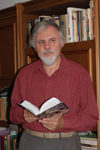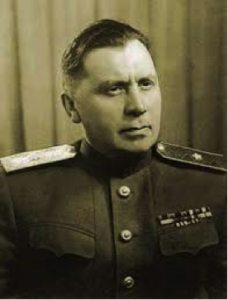By Alex Gordon


HAIFA, Israel — Nahum Eitingon was born on December 6, 1899 near Mogilev in Russia. His father was an office clerk in a paper factory. At the age of six, Nahum survived an anti-Jewish pogrom. He attended a commercial school for seven years and graduated from a high school in Mogilev. In early 1917, he worked in a cement factory.
In October 1919, Eitingon joined the Bolshevik Party. On May 10, 1920, he became an employee of the Cheka (the first Soviet secret police) in Gomel. In 1924, he completed his studies at the Eastern Department of the Red Army Military Academy. As a sign of special trust, he was sent to work abroad. He worked in the foreign department of the OGPU (the new name of the Soviet secret police) in China (1925) and Turkey (1929).
Eitingon operated all over the world – Asia, Europe, North and South America. He directed Soviet intelligence in Turkey and Greece, and established an illegal agent network in the United States, France, and Belgium. He was engaged in the organization of espionage and sabotage operations, among which stand out the assassination of the leader of North China and Manchuria Zhang Zolin (1928), the kidnapping of prominent members of the White movement, Generals Alexander Kutepov (1930) and Eugene Miller (1937) in France, and an unsuccessful attempt and then the murder of Lev Trotsky in Mexico (1940).
At the time of the successful assassination attempt, Eitingon was in a car, a hundred meters from Trotsky’s house with the mother of assassin Ramon Mercader Maria Caridad, recruited by him along with her son during his service in the Spanish Civil War (1936-1938), where he fought under the name of General Kotov. He received the Order of Lenin for the assassination of Trotsky. He was like a spy-intellectual James Bond type, was dexterous, clever, witty, charming and educated man and enjoyed success with women – he was married five times. He did not look like a typical Stalinist executioner.
From July 1941, Eitingon was deputy head of the 4th Directorate of the NKVD (People’s Commissariat of Internal Affairs) and head of the Special Group under People’s Commissar of Internal Affairs Lavrenty Beria. In 1945, he became deputy head of the department in the NKVD (later NKGB, People’s Commissariat for State Security), which was responsible for collecting and summarizing intelligence on the development of Soviet nuclear weapons.
From 1946 to 1947, Eitingon engaged in “individual” terror, one of the victims of which was an American, Isaiah Oggins, a member of the Communist Party of the United States. He and his wife Norma, U.S. citizens and Communists, cooperated with the USSR state security agencies and were used for illegal work in the U.S., Europe and the Far East. In 1938, Oggins was arrested on suspicion of espionage and sentenced to eight years in 1940. Norma sought his release, appealing to the Soviet consulate and embassy, the U.S. State Department, and wrote to Stalin.
However, MGB Minister Victor Abakumov wrote to Stalin that the MGB considered it impossible to release Oggins because he might give away the methods of Soviet intelligence and foreign agents known to him, as well as talk about the regime of prisoners in prisons and camps: “On this basis, the USSR MGB considers it necessary to liquidate Oggins Isaiah, informing the Americans that Oggins, after a visit with representatives of the American Embassy, in June 1943, was returned to the place of serving his sentence in Norilsk and there, in 1946, died in hospital as a result of exacerbation of tuberculosis of the spine.” The liquidation was approved and entrusted to Eitingon, who injected the American with a lethal poison.
In October 1951, State Security Major General Nahum Eitingon was arrested in the “Zionist conspiracy case in the MGB” against high-ranking Jewish state security chiefs, part of which was the false antisemitic case of Jewish doctors accused of poisoning the Soviet leadership. The case of the “Jewish nationalist” Eitingon was concocted. He knew his power well and predicted his future: “I am a general of state security and a Jew. There is a guarantee that I will end my days in prison.”
He was accused not only of manifestations of “bourgeois nationalism,” but also of failing to fulfill the plan of active Chekist (an officer of the secret Soviet police) activities abroad, that is, for not killing enough: On December 4, 1952, a Stalin-dictated decree of the CPSU Central Committee “On the Situation in the MGB” was passed. In the resolution, Stalin accused the Chekists of covering themselves with “rotten and harmful reasoning about the alleged incompatibility with Marxism-Leninism of sabotage and terror against class enemies […] and that they do not understand […] that one cannot represent the MGB without the sabotage it carries out in the enemy camp.” Stalin believed that his secret police, which had killed millions of people, was not bloody enough.
Eitingon spent a year and a half in prison, but was released after Stalin’s death in March 1953. The tyrant’s death was Eitingon’s salvation. He was reinstated in the state security service and his awards were returned. However, after the execution of Beria, in August 1953, he was again arrested as a henchman of the latter and sentenced to twelve years in prison. The numerous murders he committed for the benefit of Soviet power did not save him from persecution, which had an antisemitic character.
He was released in 1964 and died on May 3, 1981 in Moscow. At his funeral, Soviet Chekist, Hero of the Soviet Union Colonel Yevgeny Mirkovsky said: “Today at this grave as if the knight era in the history of our Cheka is coming to an end.” “Knights” of the cloak and dagger, retired assassins mourned the super-assassin.
Because of his kinship with Nahum Eitingon and Nahum’s involvement in the kidnapping of General Eugene Miller, psychoanalyst Max Eitingon (the subject of Part 1 of this series), was unjustly accused of spying for Soviet intelligence.
*
Alex Gordon is professor emeritus of physics at the University of Haifa and at Oranim, the academic college of education, and the author of 10 books.